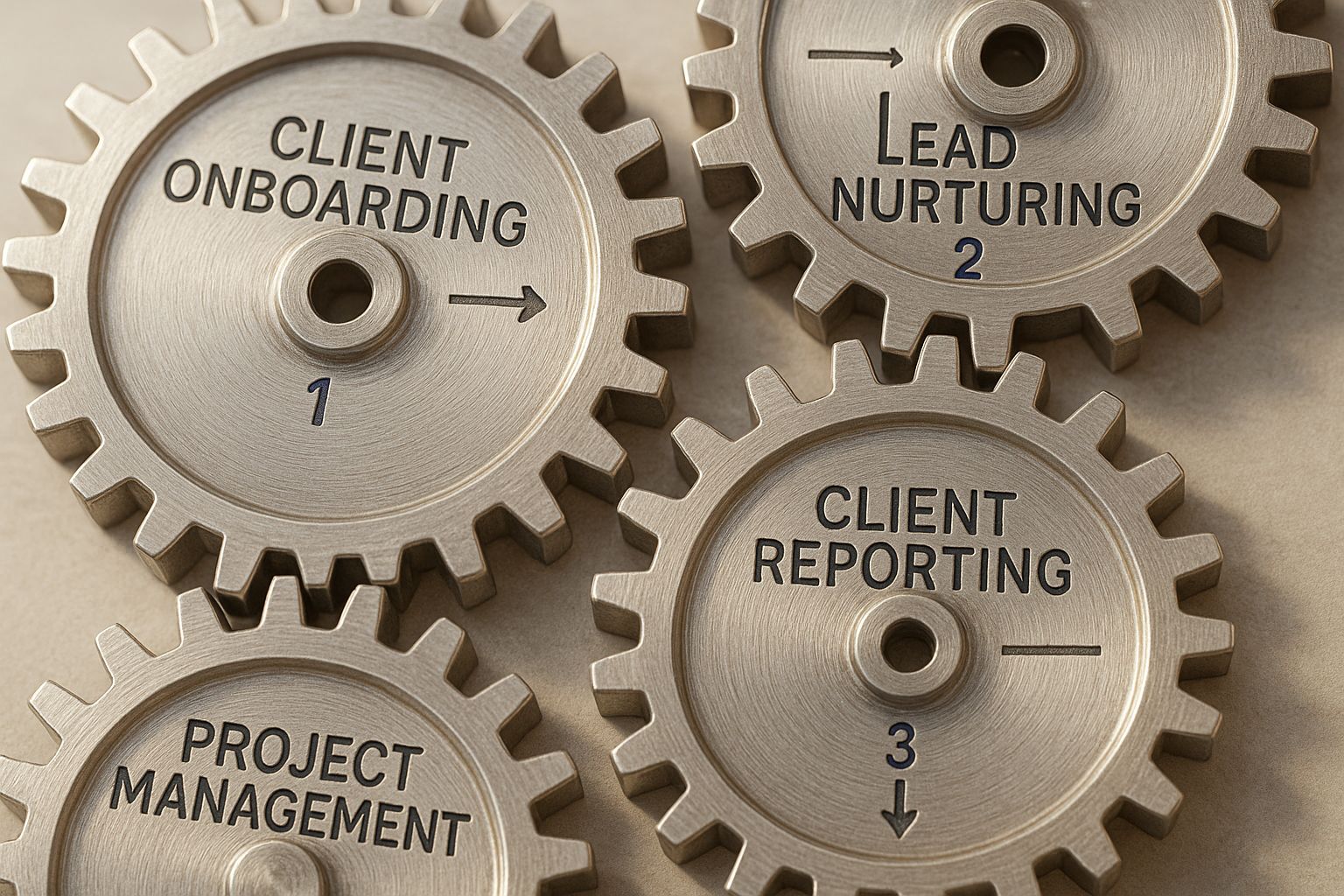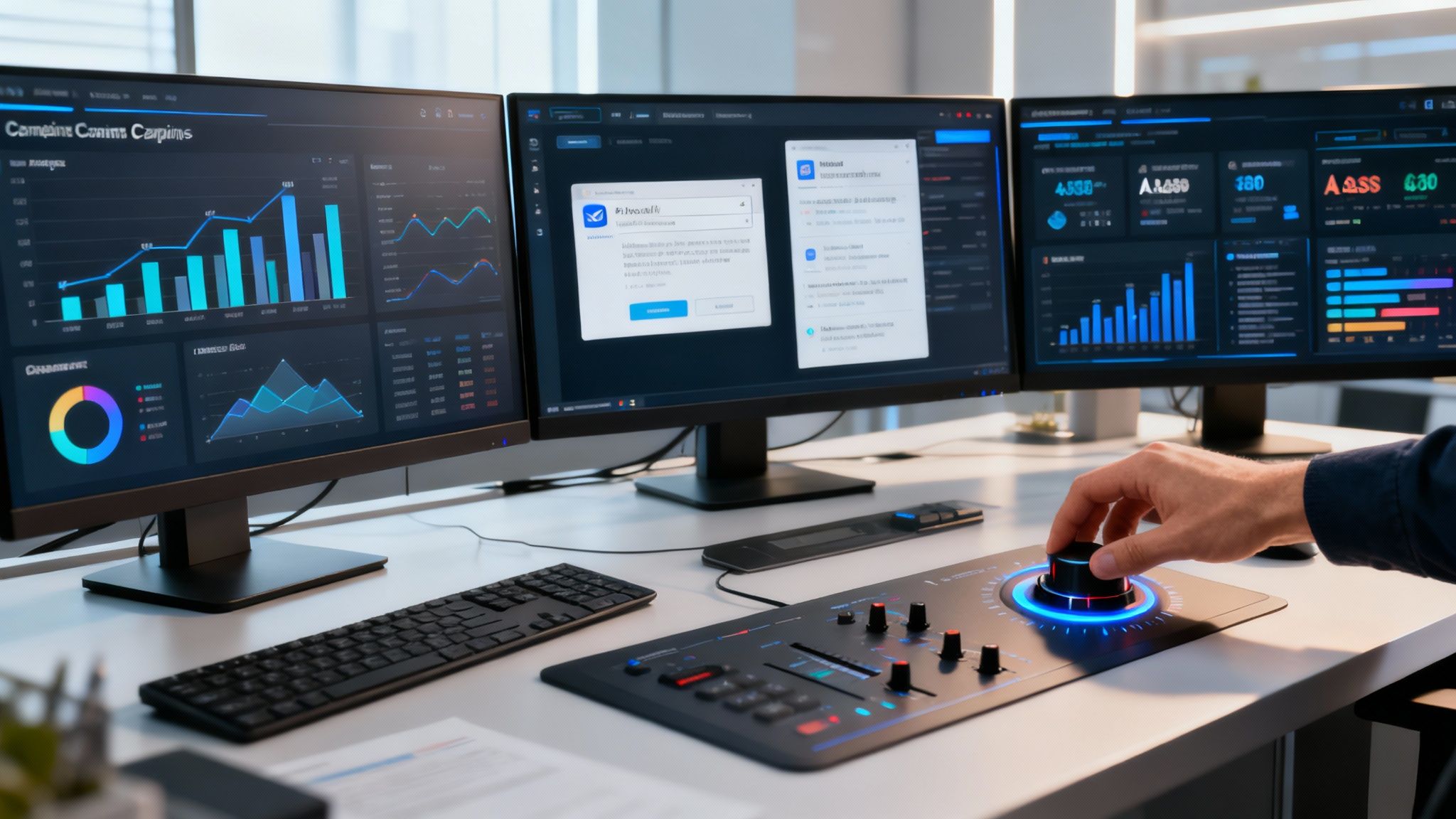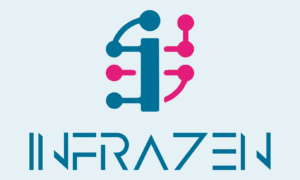Trying to scale an agency often feels like you're juggling flaming torches while riding a unicycle. You’re constantly balancing client demands, managing intricate campaigns, and proving your worth, day in and day out. This is where marketing automation for agencies comes in, not as another complicated piece of tech, but as your most reliable strategic partner. It’s the secret to getting a handle on the repetitive grind, delivering knockout results for clients, and finally building the capacity you need for real, sustainable growth.
Why Automation Is an Agency Game-Changer

Think of your agency as a high-performance race car. Your talented team- the strategists, creatives, and account managers- are the expert drivers, laser-focused on winning the race for each client.
In this picture, marketing automation is the elite pit crew working tirelessly behind the scenes. It handles all the essential but repetitive jobs with incredible speed and precision. Refuelling, changing tyres, running diagnostics- it’s all done in a flash. This frees up your drivers to do the one thing only they can do: navigate the track, find the perfect line, and outmanoeuvre the competition.
Freeing Up Your Most Valuable Asset
Your team's time and creativity are, without a doubt, your agency's most critical resources. But let’s be honest, how much of their day is swallowed by manual, soul-crushing tasks? Just think about the hours that evaporate into thin air from:
- Manually pulling and compiling data for client reports.
- Sending individual follow-up emails to every new lead.
- Scheduling dozens (or hundreds) of social media posts.
- Endlessly updating contact lists in your CRM.
Sure, these jobs need doing, but they don’t demand an ounce of strategic thinking or creative genius. They are, however, perfect candidates for automation. Research shows that 45% of companies using automation are clawing back significant time on this exact kind of work. By offloading it to a system, you give your experts the breathing room they need to focus on what truly moves the needle: strategy, creativity, and nurturing client relationships. We dig into this shift in our guide on how creative businesses can reclaim hours and boost revenue.
Automation doesn't replace great talent- it empowers it. By handling the monotonous work, it creates the space for your team to produce their best, most impactful work for clients, which is the ultimate driver of agency growth and retention.
From Manual Effort to Systemised Success
Bringing marketing automation into your agency means shifting from a reactive, labour-intensive model to a proactive, systemised one. Instead of relying on manual checklists and individual heroics, you build dependable, repeatable workflows that run around the clock.
This consistency doesn’t just make you more efficient internally. It dramatically enhances the client experience, ensuring no lead is ever dropped and no detail is ever missed. It’s about building a machine that delivers excellence, every single time.
For a deep dive into how this can transform your operations, check out this comprehensive Marketing Automation for Agencies Playbook. It breaks down exactly how to build that elite pit crew for your business.
Right, let's move past the theory. What does marketing automation actually do for an agency? It boils down to three things: making your agency run smoother, your clients happier, and your business more profitable. It’s the engine that drives sustainable growth.
At its core, automation gives you back your most valuable asset: your team's time. Think about all the repetitive tasks- pulling reports, scheduling social posts, sending routine follow-up emails. When you automate that grind, you free up your best people.
Their brainpower shifts from monotonous box-ticking to high-value strategic and creative work. That newfound bandwidth feeds directly into better campaign results and top-tier client service, which is the bedrock of any great agency.
Better Client Results, Longer Retainers
For your clients, the impact of your agency embracing automation is immediate and obvious. It lets you deliver a level of sophistication and personalisation that’s almost impossible to pull off manually. Suddenly, you're building smarter, more effective campaigns that get real results, cementing your value and turning projects into long-term partnerships.
Here’s where clients will see a tangible difference:
- Smarter Lead Nurturing: You can build intricate workflows that serve up the right message to the right person at exactly the right time. This warms up prospects, builds trust, and hands over genuinely sales-ready leads to your client's team.
- Personalisation That Clicks: Automation uses data to personalise communication at scale. Customers feel seen and understood, not just marketed to, which builds powerful brand loyalty.
- Faster, Data-Backed Decisions: With automated reporting, you can spot what’s working and what isn’t in near real-time. This agility means you can optimise campaigns on the fly, making sure every penny of your client’s budget is pulling its weight.
This isn't just wishful thinking. UK-based agencies are already seeing a massive return for their clients, especially in B2B. Take Beach Marketing, a marketing automation agency that delivered a staggering 684% ROI for Midshires Electrical. They generated 19 new trade accounts, each with an average order value of £20,000. That’s the kind of result that makes you indispensable.
Building the Foundation for Scalable Growth
When your internal operations are humming along efficiently and your clients are thrilled with their results, you’ve created the perfect storm for growth. These two pillars support a robust, scalable business model- one that doesn't depend on just hiring more bodies to handle more work.
Automation is the operational backbone that lets an agency scale without descending into chaos. It turns messy, error-prone manual processes into reliable, repeatable systems, giving you the capacity to take on new clients without burning out your team.
This systematic approach builds a stellar reputation. Consistently delivering brilliant results leads to higher client retention and, more importantly, a flood of word-of-mouth referrals- the lifeblood of any agency. To really push the boundaries, you can even look into strategies like automating content creation to scale your output without sacrificing quality.
Ultimately, marketing automation gives you the breathing room to chase new opportunities with confidence. You can onboard that exciting new client knowing your systems can handle the load. This is the strategic capacity you need to take your agency to the next level. For a structured way to get there, our guide on creating a digital transformation roadmap is a great place to start.
Essential Automation Workflows to Build First
Diving into marketing automation can feel like trying to boil the ocean. The possibilities are endless, and it's easy to get overwhelmed. The trick is to forget about doing everything at once. Instead, start small. Focus on the high-impact workflows that solve your most immediate, day-to-day headaches.
By automating a few core processes first, you’ll see results quickly, build momentum, and create a solid foundation to build on. Think of this as your playbook for getting immediate wins. We'll walk through four foundational workflows that tackle common agency pain points, from chaotic client onboarding to leads that fall through the cracks.
This infographic gives you a great visual of how these essential workflows- Client Onboarding, Lead Nurturing, Client Reporting, and Project Management- all fit together to create a well-oiled agency machine.

Each gear represents a critical part of your business. When you automate them, they start working in perfect harmony to drive efficiency and, ultimately, growth.
A Seamless Client Onboarding Sequence
First impressions are everything, right? A clunky, manual onboarding process is a recipe for friction. It plants seeds of doubt in a new client's mind before you've even had a chance to show them what you can do.
Automating this sequence ensures every single client gets a consistent, professional, and welcoming experience from the second they sign on the dotted line.
A solid onboarding workflow usually involves these automated steps:
- Trigger: The whole thing kicks off the moment a contract is marked as "signed" in your CRM or project tool. No manual start button required.
- Internal Alerts: Key team members- like the account manager and project lead- get an instant notification. At the same time, a new project is created in your management software.
- Client Welcome: A personalised welcome email lands in the client's inbox. It should include a welcome pack, outline the next steps, and provide a simple link to book their kick-off call.
- Task Creation: All the necessary internal jobs, like setting up client folders, granting software access, and prepping for the kick-off meeting, are automatically created and assigned.
This simple process gets rid of human error, stops things from falling through the cracks, and makes your agency look incredibly organised from day one.
A Powerful Lead Nurturing Engine
Let's be honest: not every prospect who fills out a form on your client's website is ready to buy. A lead nurturing workflow is designed to engage these potential customers automatically, sending them valuable, targeted content over time. It gently guides them through the sales funnel until they’re actually ready to have a conversation.
This is a game-changer for proving your agency's ROI. Instead of just handing over a raw list of leads, you’re delivering prospects who have been properly educated and qualified.
An automated lead nurturing system is like giving your client a 24/7 sales assistant. It patiently educates prospects, scores their interest based on what they do, and only flags a lead to the sales team when it's genuinely hot. It’s all about maximising efficiency and conversion rates.
For instance, if someone downloads an e-book on "social media trends," your workflow could send them a series of related articles over the next few weeks. If they then click through to a case study and visit the pricing page, their lead score shoots up, triggering a notification for a salesperson to make a personal call.
A Transparent Client Reporting System
Manually pulling together client reports is a soul-destroying, time-consuming chore that’s just asking for errors. It’s also one of the easiest and most impactful processes you can automate.
An automated reporting system can pull data from all the different platforms you use- Google Analytics, social media channels, ad networks- and pop it all into a single, easy-to-read dashboard.
This doesn't just save your team countless hours; it gives clients real-time access to their campaign performance. That level of transparency builds incredible trust and constantly reinforces the value your agency provides. Modern tools let you create branded, client-facing dashboards that update automatically, finally putting an end to that monthly scramble to pull numbers.
You can take this even further by combining it with other technologies. To learn more about how different tools can work together, check out our article on how robotic process automation and artificial intelligence are revolutionising business processes.
To give you a clearer picture, here’s a breakdown of some essential workflows.
Key Automation Workflows for Agency Operations
This table summarises the key automation sequences that can transform how your agency runs, improving both internal efficiency and the quality of your client service.
| Workflow Type | Primary Goal | Key Automation Actions | Impact Area |
|---|---|---|---|
| Client Onboarding | Create a consistent, professional first impression. | Trigger from CRM, send welcome email, assign internal tasks. | Client Satisfaction |
| Lead Nurturing | Qualify leads and prove marketing ROI for clients. | Segment leads, send targeted content, score behaviour. | Client Results |
| Client Reporting | Save time and increase transparency. | Aggregate data, populate dashboards, schedule report delivery. | Operational Efficiency |
| Project Management | Keep internal projects on track without manual effort. | Send deadline reminders, trigger dependent tasks. | Team Productivity |
Implementing even one or two of these can make a noticeable difference almost immediately, freeing up your team to focus on more strategic work.
An Internal Project Management Workflow
Finally, don’t forget to automate your own internal processes. Keeping campaigns on track often requires constant nudging and task management. Automating project management workflows ensures deadlines are met and communication flows smoothly, all without a project manager having to chase people down.
Here are a few simple but highly effective project automations:
- Task Reminders: Automatically send reminders to team members when a deadline is getting close.
- Status Updates: Notify the account manager when a critical milestone, like "creative approved," is completed.
- Dependency Triggers: As soon as one task is marked complete, automatically assign the next task in the sequence to the right person.
These small automations really add up. They reduce the mental load on your team and ensure campaigns progress smoothly without constant babysitting. By putting these four foundational workflows in place, your agency will quickly start to feel the real benefits of marketing automation– saving time, strengthening client relationships, and building a much more scalable operation.
How to Choose the Right Automation Platform
Picking the right marketing automation software is a big deal. It’s a decision that will shape how your agency works for years to come. This isn’t just about buying another tool; it’s like choosing a central nervous system for your client campaigns. The wrong one creates chaos, but the right one feels like a natural extension of your team.
Instead of just running through a list of popular names, let's build a practical framework to help you find the best fit for your agency's actual needs. After all, a platform that doesn't integrate well can quickly become a major headache- a hurdle that trips up 31% of marketers. Get it right, though, and you’ll be set up to deliver incredible client results and scale your agency without the growing pains.
First, Figure Out What You Actually Need
Before you sit through a single demo, you need to map out what you really need a platform to do. A tool that’s perfect for a B2B agency might be a terrible fit for one specialising in e-commerce. A clear list of requirements is your best defence against being wowed by flashy features you’ll never touch.
Start by asking a few honest questions:
- Who are your typical clients? Are they small local shops or massive enterprises? Their needs will directly influence the complexity you require.
- What services do you sell most? If your bread and butter is email nurturing, paid ads, or social media, you’ll want a platform that excels in those specific areas.
- What’s in your current tech stack? Make a list of everything you rely on now- your CRM, project management software, analytics tools. Any newcomer has to play nicely with them.
Answering these grounds your decision in reality, stopping you from chasing shiny objects and focusing on what will genuinely move the needle for you and your clients.
The Four Pillars of Platform Evaluation
With your needs clearly defined, you can start looking at platforms through a consistent, objective lens. Focus on these four pillars to make sure you cover all the important bases.
-
Seamless Integration Capabilities
Your automation tool can't be an island. It has to connect smoothly with your other systems, especially your CRM. A platform with solid, native integrations saves you from fragmented data and clumsy manual workarounds. Look for pre-built connections to essentials like Salesforce, project tools like Asana, and of course, Google Analytics. -
Scalability for Future Growth
The platform you choose today needs to support your agency tomorrow. Think about how it will handle more clients, more contacts, and more complex campaigns without the performance dropping or the cost skyrocketing. Does the pricing model allow for steady growth, or will you face a massive price hike after adding just one more client? -
User Experience and Team Adoption
A powerful tool is completely useless if your team finds it too confusing to use. An intuitive interface and a gentle learning curve are non-negotiable. Look for clean, logical workflow builders and clear reporting dashboards that encourage your team to jump in, not push back. Many creative teams discover the right software can radically simplify their processes, a topic we dig into in our guide on tech tools for creatives. -
Flexible and Transparent Pricing
Pricing models can be a minefield. You need total transparency and a structure that aligns with how your agency makes money. Some platforms charge by the contact, others by feature tiers. Make sure you understand exactly what’s included at each level and watch out for hidden costs on essentials like API access or priority support.
Choosing a platform is a long-term commitment. You’re looking for a partner, not just a vendor. Prioritise excellent customer support, proper training resources, and a clear product roadmap that shows they’re invested in the future.
Comparing Strategic Approaches
Different platforms are built with different philosophies. Understanding these core differences is key to aligning a tool’s strengths with what your agency offers.
Take HubSpot, for example. It’s an all-in-one ecosystem that pulls marketing, sales, and service into one place. This is perfect for agencies that want a single source of truth and manage the entire customer journey for their clients.
On the other hand, a platform like ActiveCampaign goes deep on email marketing automation and CRM. It offers incredible functionality in these areas, making it a powerhouse for agencies that build sophisticated email nurturing sequences and customer workflows.
Neither approach is better- the right choice is the one that mirrors your agency's strategy and the real-world needs of the clients you serve.
Rolling Out Automation Across Your Agency
Getting marketing automation right in your agency isn't about the software you choose. It's about your people and your processes. A smart, phased rollout is absolutely essential- it stops workflows from grinding to a halt, gets people on board faster, and makes sure your investment actually pays off.
Don't think of it as a disruptive "big bang" launch. Think of it as a strategic campaign, designed to win hearts and minds inside your own walls.
This careful approach is becoming the norm. In fact, more than 49% of small-to-mid-sized UK marketing agencies are already using some form of marketing automation. It’s part of a much bigger digital transformation spend in the UK, which has now topped £3.2 billion. That figure alone shows just how vital these tools have become for meeting client demands. You can dig into more of these UK automation trends and their impact on agencies.
Start with a Pilot Project
The best way to introduce any new system is to start small and prove it works. A pilot project is your low-risk testing ground. It lets you show off the benefits of automation on a manageable scale, iron out any kinks, and build a success story that gets the rest of the team excited.
Pick a project that offers a clear, undeniable win- either for an internal process or for a single, trusted client. Good candidates include:
- An Internal Quick Win: Automate your own monthly reporting process. When the team sees how much time they get back, they'll be sold.
- A Simple Client Win: Build a basic lead-nurturing workflow for a friendly client. It's a perfect way to demonstrate how automation can improve their lead quality without high stakes.
This approach builds confidence and creates internal champions who will do the selling for you.
Earn Team Buy-In from the Start
Honestly, the biggest hurdle to new tech is almost always internal resistance. People worry that automation is here to replace them, or that it’s just another complicated tool they have to learn. You have to get out in front of this by framing automation as a supportive tool, not a replacement.
Automation isn’t about eliminating jobs- it’s about eliminating the tedious parts of jobs. It’s the assistant that handles the repetitive tasks, freeing up your talented team to focus on strategy, creativity, and building amazing client relationships.
Communicate that message, and communicate it often. Show your team how these tools will help them offload the grind of manual data entry, report building, and follow-up emails. When they see it as a way to make their work more meaningful, they'll get on board.
Prepare for a Smooth Launch
Before you hit "go" on any workflow, a little prep work is essential. A successful launch depends on clean data and clear goals. If you don't have those, you risk automating a broken process, which just creates problems faster.
Your pre-launch checklist should have these three things on it:
- Audit and Clean Your Data: Your automation platform is only as good as the data you feed it. Seriously. Take the time to clean up your CRM, get rid of duplicates, and standardise your contact information.
- Map Your Processes: Get a whiteboard and map out your current workflows from start to finish. This will immediately show you the bottlenecks and highlight exactly where automation can make the biggest difference.
- Set Achievable Timelines: Be realistic. A phased rollout takes time. Set clear, achievable milestones for each stage to keep the project on track and maintain momentum.
By following this roadmap- starting small, focusing on your people, and prepping your foundations- you can bring marketing automation into your agency in a way that feels like a natural evolution, not a painful overhaul. Get it right, and your new system will be adopted enthusiastically and start delivering results from day one.
Managing Client Campaigns with Automation

Once you’ve got the right tools and workflows humming along, your focus can shift from endless setup to brilliant service delivery. Managing client campaigns with automation isn’t about letting a machine take the wheel. It’s about using technology to elevate your strategic oversight, freeing you up to deliver a more responsive, personalised experience.
This approach turns your daily management from a reactive checklist into a proactive cycle of constant improvement. You’re using real data to refine every touchpoint, making your client's marketing smarter, faster, and far more effective than manual efforts could ever hope to be.
Perfecting Personalisation Without Being Invasive
Personalisation is the bedrock of modern marketing, but there's a razor-thin line between being relevant and just plain creepy. Good automation uses user behaviour- like pages visited, content downloaded, or emails opened- to deliver content that genuinely helps them.
For instance, imagine a lead for your client's software business keeps visiting a page about a specific feature. An automated workflow could ping them a case study showing that exact feature in action. That’s helpful, not intrusive, because it directly answers a question they’re already asking with their clicks. The key is to use automation to respond to user signals, not just blast out generic messages.
This level of targeted communication is a huge driver of growth. The UK marketing automation market is on track to blow past £1.9 billion, mostly because small and medium-sized businesses are turning to agencies for help. They need partners who can implement tools like HubSpot or Salesforce to scale their campaigns without losing that personal touch. You can find more insights on the rise of marketing automation agencies in the UK on digitalbusbusinesstransformation.co.uk.
Driving Continuous Improvement with A/B Testing
Automation should never be a "set-and-forget" solution. Its true power is unlocked when you treat every campaign as a living experiment. A/B testing is your secret weapon here, letting you methodically test different variables to see what truly resonates with your client's audience.
You can, and absolutely should, test everything:
- Email Subject Lines: Does a question get more opens than a statement?
- Call-to-Action Buttons: Does "Get Started" convert better than "Request a Demo"?
- Entire Workflow Branches: Will a punchy three-email sequence outperform a five-email nurture?
By building these tests directly into your automated workflows, you’re collecting data 24/7. This creates a powerful feedback loop, ensuring your client's campaigns are always evolving based on real-world performance, not just a hunch you had in a meeting.
The most successful agencies view automation as a tool for learning. It provides the scale and data needed to test hypotheses quickly, turning every campaign into an opportunity to get smarter and deliver better results.
Preserving the Crucial Human Element
Perhaps the most important part of managing client campaigns is knowing when automation needs to step aside. Technology is brilliant at scaling repetitive tasks, but it can’t fake genuine human connection. The best marketing automation for agencies includes triggers that bring your team in at just the right moments.
Pinpoint those key points in the customer journey where a personal touch is more powerful than any automated message. This could be when a lead hits a high engagement score, requests a detailed quote, or even expresses a bit of frustration.
At that moment, the automation should pause and create a task for an account manager to reach out with a personal email or a quick phone call. This ensures automation enhances your client relationships, not replaces them. It becomes a sophisticated alert system, letting your team apply their expertise and empathy precisely when and where it matters most.
Common Questions About Agency Automation
It’s only natural to have a few questions before diving into agency automation. Let’s be honest, it’s a big shift in how you run your operations, handle client projects, and plan for the future.
We hear the same worries crop up time and again from agency leaders. So, let's cut through the noise and tackle them head-on with some practical, straight-up answers.
Will Marketing Automation Replace Jobs at Our Agency?
This is easily the most common question, and the answer is a firm no. Think of automation as a way to enhance your team's talent, not replace it. It’s brilliant at taking over the monotonous, low-impact tasks that drain everyone's time- things like sending follow-up emails, pulling data for reports, or scheduling a month's worth of social media posts.
By getting that work off their plates, you free up your team to do what they do best. Your strategists can spend more time strategising, your creatives can focus on creating, and your account managers can build those rock-solid client relationships. It’s about letting humans do the high-value work that grows the agency.
How Much Does Marketing Automation Cost for a Small Agency?
The price tag can swing wildly based on the platform you choose, how many contacts you’re managing, and the specific tools you need. But it’s far more affordable than most agency owners assume.
The investment in automation shouldn’t be seen as just another expense. View it through the lens of efficiency gained. A modest monthly fee can return a massive amount of saved hours and better client results, making it one of the smartest investments an agency can make.
You can get started with powerful platforms like ActiveCampaign for under £100 a month. Bigger, all-in-one systems like HubSpot have a higher starting point but often bundle in a CRM and other tools you’d otherwise pay for separately. The key is to match the cost to your growth plans and what your clients actually need.
How Do We Prove the ROI of Automation to Our Clients?
The secret here is closed-loop reporting. You get this by linking your marketing automation platform directly to a CRM. This connection creates a seamless trail, letting you follow a lead from their very first click- say, downloading an e-book- all the way through to the moment they become a paying customer.
With that end-to-end visibility, you can draw a straight line from a specific marketing campaign to real, tangible revenue. Instead of just showing clients vanity metrics like clicks and open rates, you can hand them a report that proves, with hard data, the incredible value your agency is delivering.
At InfraZen Ltd, we help creative and marketing agencies put the right technology in place to fine-tune their workflows and lock down their operations. If you’re ready to build a more efficient, scalable, and secure agency, let's have a conversation.

